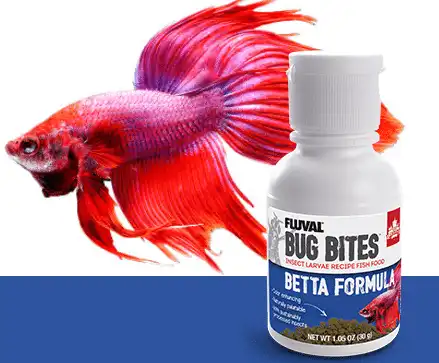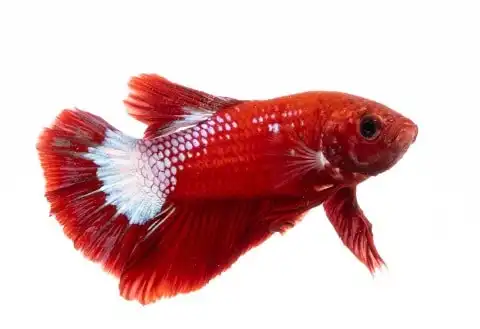Thank you for visiting! By the way… any links on this page that lead to products on Amazon and other stores/partners are affiliate links Aquarium Store Depot earns a commission if you make a purchase.
If you’re looking for a fish that keeps you occupied with its fascinating activities, then the Plakat Betta is the right species to try out.
There are a lot of misconceptions about the fish in the aquarium line. And because of that, you might mistake them to be on a completely different care level than on what they originally are.
To help you understand their behavior, care requirements, gender differences, and breeding process, we will walk through this extensive care guide together.
Key Takeaways
- Plakat Bettas are a breed of Bettas that have shorter fins
- They are more active and athletic than fancy fin Bettas
- Female Plakat can be colorful compared to other female betta types
- They are hardier than most other Betta types
An Overview
| Scientific Name | Betta splendens |
| Common Names | Siamese fighting fish, Plakat Morh, Plakat Betta, Wild Betta, Thai Betta, Shortfin Betta, Dragonscale Betta, Halfmoon Plakat Betta |
| Family | Osphronemidae |
| Origin | Southeast Asia |
| Diet | Omnivore |
| Care Level | Intermediate |
| Activity | Nocturnal active fish species |
| Lifespan | Up to 5 years |
| Temperament | Semi-Aggressive |
| Tank Level | Top |
| Minimum Tank Size | 10 gallons |
| Temperature Range | 72-82 F° |
| Water Hardness | 2 to 12 dKH |
| pH Range | 6.0 to 7.5 |
| Filtration/Water Flow | Moderate to fast |
| Water Type | Freshwater |
| Breeding | Egg layer |
| Difficulty to Breed | Moderate |
| Compatibility | Solo or Community tanks (with caution) |
| OK, for Planted Tanks? | Yes |
What is It?
Plakat Betta, famously termed as Siamese fighting fish, is a part of the Osphronemidae family. They are a variant of Betta Fish though slightly less popular than their cousins.
Their enticing kaleidoscopic bodies make them ideal candidates for dull tanks. Another appealing fact is their lively activities.
The fish is not the best option for beginners. The reason is their territorial instincts and strong interest in attacking some tank mates to death.
Origin and Habitat
Plakat bettas are native to Southeast Asia. The regions include Cambodia, Thailand, Indonesia, Malaysia, Laos, Vietnam, and Myanmar.
They were first sighted in Thailand by King Rama III almost 150 years ago. They were initially distributed within different Thai regions. But with time, the fish made successful attempts at inhabiting aquariums around the world.
Their water conditions and pH levels might slightly differ due to their different origins. We are going to discuss that in depth so stick around till the end.
Appearance
When it comes to offering a ton of different shades, Plakat Bettas are invariably ahead of other fish in the competition.

There are several varieties of them traded around the world. Some of them feature a silver base and sharp blue-colored fins with red patches scattered across their fins and overall bodies.
While the others come in a spectrum of deep-red fins with a touch of orange at the edges. These fish also have a bright silver base laced with deep blue hues. These patches are usually visible at their anal fins.
You might also see some Plakat Bettas featuring their full bodies in a lighter shade of mauvelous pink. The others, however, can report bright yellow fins with shimmery tons of blue. The head looks pink and sometimes red in these species.
If you have a prior experience with bettas, finding the most common variant will be pretty easy.
Plakat Bettas have cylindrical-shaped bodies. As a result, they look quite compressed when compared to a standard betta.
There are only minor differences to tell them apart. One of which is the head. The head recedes to a certain point at their mouths. They have upturned mouths which add to their uniqueness.
However, one of the major differences between them is the fins of Plakat Bettas. They have sword-like pelvic fins, circular-shaped dorsal fins, and elongated anal fins. Their dorsal fins are apparent on the lower side of their back.
Overall, the Plakat Betta has a dramatic tail and a strong frame.
Their fins are generally smaller, helping them stand firm against their opponents. Another reason why they are called strong fighting fish is the prominent rays on their tail and dorsal fins. These rays help them protect their fins from shedding.
Typically, bettas with long flowing fins are seen in aquariums. These long-finned bettas are prone to fin nipping and fin rot. And that’s why aquarists only house them with peaceful fish species.
As common with other fish, telling their genders apart is easy.
The male Plakat Bettas are brighter than the females. They also look larger when compared to their female counterparts. The female Plakat Bettas, however, have multi-colored fins that set them apart.
While in the deeper levels of water, the fish often travel up to the surface. Aside from their gills. they have a labyrinth organ that helps them respire oxygen from the air.
There are some common varieties available in the aquarium line. Here are a few of them that might strike your attention.
Types
There are several Plakat Betta types you can try. Here are the most popular below
1. Dragon
Dragon Betta (video source) or Dragon Scale Betta is variety of Plakat Bettas. They feature a metallic-colored base and sharply pointed scales.
The color of their scales can vary from deep black to reddish brown.
2. Samurai
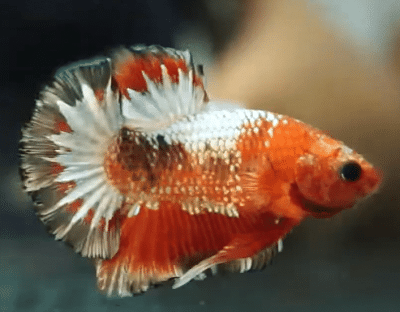
From the repeated attempts of breeding the Dragon Betta over a lengthy period, the result came out beautifully shocking and unique.
The Samurai Betta might look like the Dragon Betta. But, it has a strong deep black base color with a silver coating around the scales.
There’s another coating of the same shade on the face. You can also see a thick silvery band running lengthwise down its body to the edges.
Samurai Bettas sometimes have their heads covered with white gold, with their middle body sections completely devoid of color patterns. Other times, they have shimmery silver shades striking their fins, backs, and heads.
3. Blue Rim
As a result of intense breeding taking place over the years, this is another beautiful type of Plakat Betta (video source).
The fish from this category has up to 3 different shades. The base appears white, with the fins having a beautiful shade of blue. Sometimes the base can look different depending on the lighting.
4. Nemo
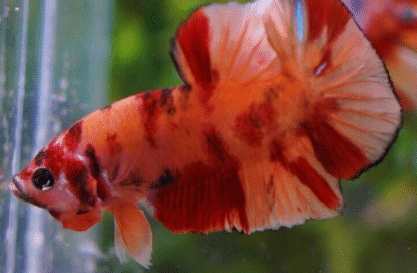
Nemo Betta or the classic Nemo Betta has two different shades. It has a deep red color and a cool shade of melon.
The classic Nemo Betta is often confused with the multi-colored. The easiest way to distinguish them is by looking at their colors.
5. Mustard

Mustard Betta though extremely rate to find is another betta variety.
This type of Plakat Bettas was bred almost 25 to 30 years ago. They are now going extinct due to this fact.
These fish have blue bottoms with mustard-colored fins. Their fins can vary in the deepness of color depending on the process of breeding.
Their fins are not completely the color of mustard. You can light hues of their base color connecting the fins to their bottoms.
While swimming, their fins spread out like fans. And this makes them more enticing to watch.
6. Hellboy
The Hellboy Betta fish (video source) got its name from its unique appearance. This variety of Plakat Bettas has a color combination of charcoal black and bright red.
Like some other types of Plakat Betta, this category is also quite rare to find.
7. Koi Plakat
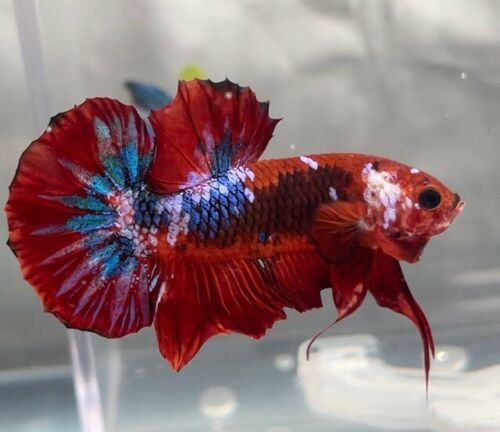
The Koi Plakat Betta is a high-grade colored fish. Every individual fish from this variety has over 5 different colors which look amazing to the eye. The body coloration in these fish is usually strong, with different shades mixing into one another.
Plakat vs Halfmoon Plakat Betta
The major difference between a Plakat Betta and a Halfmoon Betta is their fins.
If you compare Plakat Bettas with their cousins, fins will be the most noticeable difference among them.
A Halfmoon Betta has long fins. But to dart quickly around, on the battlefield, A Plakat Betta needs short fins to protect them from getting ripped up.
Another contrasting difference is their anal fins. Unlike Plakats, Halfmoon Bettas have shorter anal fins. These fins extend from their abdomens. While the former species have elongated anal fins that project from their backs.
Lifespan
The generally predicated lifespan of healthy Plakat Bettas is between 3 to 5 years.
However, their life expectancy can improve with the level of care and efforts you put into their maintenance.
As Plakat Bettas are almost always in the game of fighting other fish to death. As a result, their overall life endurance can get seriously influenced. So, it’s always better to monitor them closely for as long as possible.
Average Size
Plakat Bettas are pretty small, reaching up to 2 to 3 inches in length only. There’s no difference between the Plakat Bettas coming from the wild versus those who are captive-bred.
Care
In this part, I’ll give you some insights into exactly what goes into their proper management.
Since these fish are infamous for their high territorial behavior, you should be careful about this.
It’s almost impossible for them to open themselves up to other species. The acceptance rate is low. And there’s no way to stem the flow of their constant aggression.
But a proper care guide can improve their health. Apart from food requirements, proper tank setup and water parameters also hold intrinsic value to their transition.
Aquarium Setup
The fish in the wild inhabits areas with low oxygenation levels and high vegetation. They are sometimes found in rice paddies and small rivers and basins.
These fish are naturally trained to adapt to slight acidic-level changes and water shifting. But it’s good to replicate their natural habitat as closely as possible.
They are active swimmers who love to travel. While setting up their tanks, keep the surface open. If the oxygen levels are low, these wild bettas will use their labyrinth organ to fill in their oxygen needs from the surface.
Tank Size
Due to their small size, they are often sold in tiny jars and containers. While the stay in these jars is momentary, beginners fail to realize that they are active fish species.
The minimum tank size of a Plakat Betta is 10 gallons. Because they prefer staying alone, this is a good aquarium size. However, thick supplementation of live plants might disturb their free movement.
Therefore, a larger aquarium setup is better.
Water Parameters
These tropical fish prefer warm water temperatures. So, in their aquariums keep the temperature between 72° F to 82° F. The water hardness should be around 2 to 12 KH with slightly high acidic levels.
But to keep the pH levels accurately regulated, get a water testing kit. You can also use almond leaves in their tank for proper pH control.
Filtration and Aeration
Although these fish are kept alone, negligence in environmental cleanness can lead them to fish diseases.
To give them a healthy environment, you can go for a hang-on-back filter or a sponge filter. A strong filtration system weeds out toxins like ammonia and nitrate, making it safer for your fish to live.
The Best Aquarium Power Filter
The worlds best selling and most reliable power filter on the market. Unchanged for years because it's so reliable and versatile
Lighting
Unlike other freshwater fish sensitive to bright lighting, things are different for a Plaket Betta. The fish in the wild is often exposed to natural lighting. They frequently travel to upper water levels to breathe using their labyrinth organ. As a result, their tolerance of bright lighting is pretty good.
While constructing their habitat, you can replicate this condition completely risk-free. You will always see them active during the day while taking rest throughout the night. When the sun goes down, just dim the aquarium light for your fish’s comfort.
Aquatic Plants and Decorations
Plaket fish gives you the freedom to choose what goes into their tanks.
In their natural habitat, you can see a lot of plants. There are caves, as well as other hideouts that they use during the night hours. But these hiding spots will be beneficial if the fish is stressed.
An anxious Plaket Betta fish losses its ability to withstand potential environmental changes and personal adversities. To keep their remaining energy intact, the last resort is almost always caves or other hideouts.
Also, make sure to introduce live floating plants. Some great recommendations can be Java Fern, Java Moss, Moneywort, Anubias Nana, and Narrow Leaf. These can boost oxygenation levels which is strongly advisable.
For caves, both rock caves and plastic caves are great. Just make sure the edges are smooth because jagged surfaces can hurt your pet.
While using live plants, leave plenty of space on the surface so that the fish can head toward the surface for breathing.
Tank Maintenance
Regardless of how small you think your fish is, tank maintenance holds great importance. Not only does it help you with protecting your investment from going to waste, but it is also essential for your fish’s health.
The easiest way to do this is to follow these tips.
- Take out plants that have worn leaves and remove dead leaves.
- Use an algae scrubber to clean off the aquarium walls.
- Get all the decors out of the tank and wash them off with aquarium water and a toothbrush.
Substrate
They are originally from Southeast Asia where they live in rice paddies and warm water areas. Generally, these areas have a sandy substrate that’s really soft to the touch.
So, adding a good layer of sandy substrate to the base of their aquarium is ideal. You can also use soft rocks and driftwood.
Community Tank Mates
While it’s true that these fish are largely kept solo, you can still find some good tank mates for them in a community tank.
Mostly, the male Plakat Betta has no tolerance for its parallel. The moment two males bump into each other is the moment they start fish fighting. The reason is simple yet quite funny. Both males think that the other will take hold of their territory. To stop the other, they start fighting.
While the males can’t coexist, females have no problem sharing the same tank.
Here are some good tank mates to consider.
- Honey Gouramis
- Cory Catfish
- Diamond Tetras
- Congo Tetras
- Cherry Barbs
- Odessa Barbs
Poor Tank Mates
Any fin-nipping fish is a poor choice for Plaket Bettas and long-finned bettas. Avoid these fish from housing with a Plakat Betta fish.
Breeding
Breeding Plakat Bettas is of course challenging. But it’s not impossible even if you’re a novice. All you need is proper guidance that can lead you to successfully breeding them.
Create a separate breeding tank for them. Then, heat up the water using a heater. You can also cover the surface to raise the temperature. The ideal water temperature should be above 78° F and below 80° F.
The pre-conditioning system should be based on feeding them high-quality protein foods. The timeline for getting ready to mate is at least 2 weeks. In these two weeks, you have to feed them a protein-based diet twice or thrice a week.
After this, guide the pair to the breeding tank. Let them get comfortable with the transition while feeding them the same diet.
While mating, the female Plakat Betta will show deeper shades of colors. The male as a typical methodology will keep chasing her until she gets filled with eggs.
Once they are done, the male will make a bubble nest. To support the nest, there should be plants already in the tank.
The first indication of successful mating and breeding is the male Plakat Bettas blowing bubbles up to the surface. The female will then release the eggs into the water which the males will take to the nest.
The male will fertilize the eggs until they are ready to hatch. It takes them up to three days to hatch. At this point, remove the parents because they can eat up the fry.
The babies take a couple of days to move from egg sacs to other foods. You can give them powdered food at the start. Then, move on to feeding them baby brine shrimp.
Food and Diet
In the wild, these carnivorous fish hunt down insect larvae and bug larvae to thrive. Brine shrimp, micro worms, and other live food are some other sources of protein that they need for healthy survival.
In the aquarium, the diet Plakat Bettas prefer is no different! It is also quite an easy dietary task to perform.
Best Betta Food
Fluval bug bites is made of various insect and shrimp ingredients making this a high quality source of protein
Sometimes you might find it demanding to give these foods to them. As a result, you will go for commercial foods that pet stores sell. But remember to use a high-end brand. Many pet stores use chemicals in fish foods that are toxic for your pet.
Common Health Problems
Almost every freshwater is susceptible to fish diseases. In the Plakat Betta case, there is no exception. However, they are quite resilient and able to ward off common ailments easily.
According to our knowledge, selective breeding is the prime reason that they withstand common health issues. Here are some common diseases with symptoms of the diseases.
Fin Rot
Plakat Bettas can fight off fin rot, unlike long-finned bettas who are an easy target.
But, not attending to your fish can result in their catching this common disease in freshwater
Some common symptoms of fin rot are:
- Black, white or brown dots on fins or other body parts
- Ragged edges to the fins or tail
- Loss of appetite
- Lethargy
Swim Bladder Disorder
This disease is usually caused by overeating in betta fish.
Symptoms are:
- Staying at the bottom
- Curved back
- Unable to stay upright
- Change in appetite
Ich
Ich is another common disease in fish. This ailment can attack long finned bettas, as well as your biting fish.
Some common symptoms are:
- Lack of activity
- Unable to stay focused
- Visible weakness
Where To Purchase
The best place to purchase Plakat Betta is likely going to be from an online seller. You can also find them at local fish stores, but the best varieties are usually from premium specialized sellers. The link below goes to a trusted seller of ours who sells What You See Is What You Get (WYSIWYG) fish. Give them a try!
Use Coupon Code ASDFISH at Checkout
Betta Fish are one of the most beautiful varieties of freshwater fish available in the hobby. Easy to care for with plenty of varieties!
FAQs
Are they more aggressive?
Plakat Bettas are the most aggressive member of their family. Adult Plakat betta tends to show hostility if their domain is endangered.
How do I know if my fish is a Plakat?
The easiest way to identify your Plakat Betta fish is by looking at its tail. Another possible way is to see their reaction to their own species and tank mates.
How much does it cost?
Plakat Bettas are quite inexpensive. They usually cost 5$ to up to 7$. However, if the type that you’re looking for is rare, the price can certainly go up.
Is my fish male or female?
Males are typically brighter, but the fins of a female look more beautiful. Another difference is in their size. The male Plakat betta goes over the general size of a female, which is 1.7 inches to 2 inches.
Closing Thoughts
If you’re looking for an active and beautiful fish to add to your aquarium, the Plakat Betta may be perfect for you. With a little research into their temperament and what other fish they can live with, you can have these fascinating creatures swimming in your tank in no time. Have you kept Plakat Bettas before? Let us know your experience in the comments!
- About the Author
- Latest Posts
I’m thrilled that you found Aquarium Store Depot! Here you’ll find information on fish, aquariums, and all things aquatics related. I’m a hobbyist (being doing this since I was 11) and here to help other hobbyists thrive with their aquariums! I adhere to a high quality Editorial Process and Review products with real life field usage and practical analysis.



